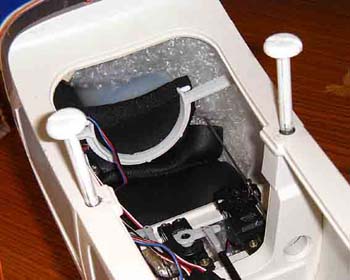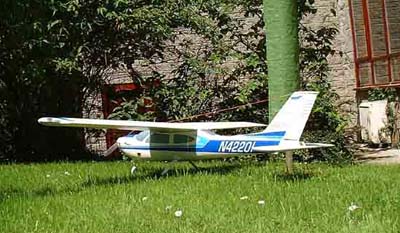

| The ARC Modelfly Cessna 177 Cardinal |
I've built two other ARC planes in the past (Ready 2 and the Jupiter), and so enjoyed building such great quality kits that I went for the larger, prettier scale Cessna. RCM&E has already reviewed this plane (last month), so this is only to back it up, or to add my own points.
The kit has only one piece of wood, a rear stab spar; all the rest is ABS plastic or reinforced nylon. As ARC claims, all parts really are precisely cut - extremely impressed.
 Building
Building
The
main airframe can be done in a weekend. It goes together so well! As the
mag review said, installing the steering mechanism for the nose wheel
is a bugger! I had to enlarge the access hole in the firewall downwards,
almost so that it touched the join, to ensure smooth movement of the piano
wire. This was the only building problem I encountered however; I didn't
experience the engine installation trouble that the mag talked about.
I expect this was because I used a size down from them - an OS 52 four-stroke
(underpowered according to the specs, but it's what I had!)
Actually this isn't quite true - I did have to mod the engine mount, which was too large for the engine (I glued a piece of nylon inside of one of the forks. It seems to work very well). One snag with precision cut plastic parts is that you have to use what's there. A smaller mount won't fit the firewall moulding. One of the greatest plus points re: building, are the instructions. Photos are many and beautifully clear, and the text is written in several languages, including strangely, well-translated English!
 There
is one area where I would deviate from them though. This is the material
recommended for bonding ABS plastic parts, like the bulkheads and firewall.
Epoxy or cyano is recommended. I definitely wouldn't use epoxy - it won't
take to plastic like it does to balsa, even if surfaces are well roughened.
I only used it for sealing the firewall, after it had been glued. Cyano
is OK, but Plastiweld is what you really want. It's a clear liquid, painted
on with a brush, and works like a cement - lightly dissolving the met
surfaces and welding them together. There's no way that firewall is going
to move! Plastiweld
doesn't take to reinforced nylon however. Cyano works well here.
There
is one area where I would deviate from them though. This is the material
recommended for bonding ABS plastic parts, like the bulkheads and firewall.
Epoxy or cyano is recommended. I definitely wouldn't use epoxy - it won't
take to plastic like it does to balsa, even if surfaces are well roughened.
I only used it for sealing the firewall, after it had been glued. Cyano
is OK, but Plastiweld is what you really want. It's a clear liquid, painted
on with a brush, and works like a cement - lightly dissolving the met
surfaces and welding them together. There's no way that firewall is going
to move! Plastiweld
doesn't take to reinforced nylon however. Cyano works well here.
The fuz has a cut out designed to allow large two stroke silencers to be used. If using a four stroke, a fairing is supplied to fit over the cut out - very nice and neat. Only thing is, if you cut it away slightly to allow silencer access, it leaves a whopping great hole to fill up with oil, etc. In my case the hole was too big to fill in with epoxy, so I covered it with masking tape and epoxied over that. (Nice to see I'm one up on RCM&E - they left theirs with a thumping big hole)!
Decorating
It
really does come up well with all the stickers applied. Each is an extremely
accurate fit. If I was 'to-the-mill' fussy I would have used the soapy
water trick, but I got away without this. I was conscious of weight with
my little engine so I didn't paint the model. It still went down splendidly
at the flying field!
Radio
Nothing
much to say here - the fuz is big so there's plenty of room for servos.
Using extension leads for the aileron servos eases fitting the wing, and
means that you can leave the receiver alone once in place.
Flying
 Last
month RCM&E promised to write about it's suitability as a trainer
in the next edition. They never did! I'm a relative beginner and a trainer
is exactly what I need.
Last
month RCM&E promised to write about it's suitability as a trainer
in the next edition. They never did! I'm a relative beginner and a trainer
is exactly what I need.
Running the engine in the workshop revealed a serious problem. The fuel tank is supported at the front through a hole in the firewall, separated and insulated by a ring of silicone. This is fine. At the back though, it's supported by a nylon saddle, and directly glued to the fuz. The saddle is an exact fit to the tank, so using foam for insulation is not an option. Therefore the vibes from the engine slosh up the fuel when half-full, causing air bubbles to shoot up the line and cutting of the engine.
This was no good so instead; I packed the void around the tank with foam, wrapped the saddle in foam, then glued the saddle plus foam aft of the tank to stop it moving backwards. This has solved the problem.
So
What Did I Think?
In summary it is a fantastic trainer. Unlike your standard Tiger trainer
(or similar), it is heavy (all up is 3400g), so really does hold its own
in gusty weather. It is also silky smooth. Was anyone at Sandown recently?
Maybe some of you saw the Multiplex Magister trainers in flight. Even
flown by experts I noticed that they were jerky in flight. The Cardinal
is silky smooth and very scale  like.
like.
I was worried that the .52 four-stroke engine might struggle, so a mate at the club (much better pilot than me) took it off for its maiden flight. It needed the whole strip length to get off, and needed full up elevator. Once under way however, it climbed very well. Cruising hands off is no problem (even for me!), but need full up trim to stay level.
I have since discovered that the C of G, although correct as per instructions, is probably too far forward. The instructions state 75mm aft of the leading edge, which is 29% of the mean chord. I have moved this aft to 33% by moving the battery, so this might correct the forward balance bias - but I have yet to fly in this configuration!
My favourite way of attaching the aerial is with a brass 'S' hook is butt jointed to the fin with cyano. This is a weak joint, so when you hang it in a tree it comes loose, and you don't pull the aerial / fin to bits!
I really like using the small engine in this big plane. Sure, it won't pull long loops or do crazy aerobatics, but that's not what the Cardinal is about. With a well-balanced prop and ali spinner (I use a Top Flite magnetic balancer) it is 'whisper' quiet with a standard silencer, and gets great oohs and aahs from the crowd after low passes!
On full power it is surprisingly quick (fuz and wing are very slippery), but will crawl into landing before a stall on full up elevator. One thing though, weight and slipperiness mean no steep approaches! It takes a while to slow down. I toyed with using flaperons (it's possible to install two aileron servos, which I like), but they are only useful for slowing down a fast approach. Don't use them near stall speed, or it will tip stall, due to the ailerons being of strip type.
 I
was concerned about the main landing gear being made from reinforced nylon
instead of steel, but after several half-landing, half-fall out the skies,
they show no sign of breaking.
I
was concerned about the main landing gear being made from reinforced nylon
instead of steel, but after several half-landing, half-fall out the skies,
they show no sign of breaking.
For the absolute beginner, maybe the Cardinal is a little fast. It doesn't allow as much thinking time as some others. But it is such a sweet flyer, and near bullet proof in construction (I have never ever broken the back end of the Ready, Jupiter or this one despite ruthless provocation), that maybe with buddy box, I would say this is an excellent place for a newcomer to put his cash (£100 - £120).
Any
bugbears? Well, Ripmax is the distributor, so at the moment, unless your
shop has it in stock, your gonna wait a loooooong time for it to arrive.
And the fuel tank support system is rubbish. But that's it. I love this
plane, the best ton I have ever spent!
bensmith2514@hotmail.com
should anyone have any comments!
The ARC Modelfly Cessna 177 Cardinal is available from:
Ripmax Stockists
| Technical Details - Cessna 177 Cardinal | |
| UK Distributor: | Ripmax |
| Manufacturer: | ARC Modelfly |
| Aircraft Type: | Semi-Scale Powered Aerobatic Trainer |
| RRP | £100 - £120 |
| Wingspan | 170cm |
| Wing Area | 44 dm2 |
| Wing Section | Symmetrical Section Airfoil |
| Weight | 3300 - 3500g (all up, dry) |
| Engine | 60 2-stroke; 70 4-stroke |
| Number of Channels: | 4-5 Channel Radio |
| Control Functions: | Elevator, Aileron, Throttle, Rudder, Flaperons (optional) |
| Construction | Plastic ARTF |
| Likes | Dislikes |
|
|
Please
mention 'Flying Sites' when contacting
Ripmax
| Info Panel |
|
ARC
Modelfly
Cessna 177 Cardinal Distributed By Ripmax |
| Comments: The best 'ton' I have ever spent! |
| Price: £100-120 |
| See Technical Details Below |